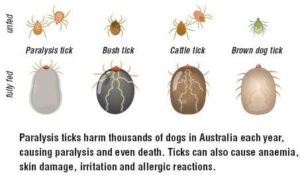Paralysis Ticks
There are 3 main types of tick; the brown cattle tick, bush tick and the paralysis tick and they look very similar. The brown and bush ticks may cause local itchiness and dermatitis, however, the paralysis tick (Ixodes hylocyclus) is one of the most dangerous parasites that can affect your pet.

Paralysis ticks are found along the eastern coast of Australia from North Queensland to Northern Victoria. In Sydney they can potentially occur all year round, but the main season begins in spring and finishes in late autumn.
Ticks are generally found on animals that live near or visit bushland or the beach. They can be carried into your yard by visiting possums and bandicoots which are relatively immune to the effects of the toxin. However, the toxin does affect the nervous system of dogs and cats and causes progressive paralysis which is a potentially fatal disease.
A tick will crawl onto an animal, bury its head deep into the skin and latch on using its barbed mouth parts.
When a tick first attaches to your pet it is very small, and will spend some time sucking blood before injecting enough toxin to cause signs of illness.
Studies have shown that even with treatment there is a 5% death rate.
What are the Signs of Tick Paralysis?
- Appearing wobbly, uncoordinated and weak – this usually is most notable in the hind legs, progressing to the front lets
- Change in bark or voice
- Difficulty breathing or panting or grunting
- Retching, coughing or vomiting
- Progressive paralysis and respiratory failure
Symptoms of tick intoxication start 48-72 hours after tick attachment, but can take up to one week before symptoms develop.
What Should I Do if I Find a Tick and My Dog Has Symptoms?
Remove The Tick trying not to squeeze the engorged abdomen. Tick Twisters, tweezers, long fingernails, forceps or a piece of cotton (looped around then tied with a knot to remove the tick where it is attached) may be helpful. If you are unsure how to remove the tick, leave it for the vet to remove. If you remove it at home, keep the tick to show your veterinarian.
Don’t Forget To Search For More Ticks
Seek Veterinary Attention as soon as possible. In the meantime do not offer food or water, if your pet can’t swallow properly, this can cause breathing difficulties or pneumonia.
An antitoxin is available, and works best the earlier it is given. Signs worsen over time, so even if very mild signs are present it is important to treat this condition promptly.
Most pets require hospitalisation for several days. Severely paralysed animals can require intensive treatment including ventilator support.
Animal nee to be kept quite for 2-3 weeks following intoxication as the tick toxin can affect the rhythm of the heart.
Prevention Is Better Than Cure!

Search your pet every day for ticks – even if tick preventative products have been applied.
In addition to physical daily searches, tick preventative products will greatly reduce the risk of tick paralysis to your pet.
- Frontline Spray – every 3 weeks, from 2 days old
- Nexgard Tablet – every month, from 8 weeks old
- Bravecto Tablet – every 3 months, from 8 weeks old or > 2 kgs in weight
- Frontline Topspot – every 2 weeks, from 8 weeks old
- Advantix Topspot – every 2 weeks, from 7 weeks old DO NOT USE ON CATS
- Permoxin Rinse – every 2 weeks, from 12 weeks old DO NOT USE ON CATS
- Seresto Tick Collar – protects for 4 months for ticks and 8 months for fleas, from 10 weeks old








